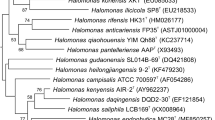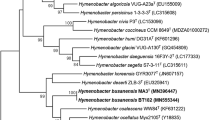Abstract—
Screening of ability to utilize benzoate as the sole carbon and energy source was carried out for 124 strains of the family Halomonadaceae (genera Halomonas, Chromohalobacter, Salinicola, and Kushneria) isolated from mining sites of the Upper Kama deposit of potassium and magnesium salts. Active growth on benzoate (in the presence of 30‒70 g/L NaCl) was shown for 28 Halomonas strains closely related to the species H. taeanensis, H. olivaria, H. ventosae, H. titanicae, H. alkaliantarctica, H. neptunia, H. radicis, and H. sulfidaeris. Strains of the genera Chromohalobacter, Salinicola, and Kushneria either did not grow on benzoate or carried out its transformation (two Chromohalobacter strains). PCR screening for the benA gene encoding the α-subunit of benzoate 1,2-dioxygenase (1,2-DO), the key enzyme for benzoate degradation, within the family Halomonadaceae revealed its presence in all benzoate-degrading Halomonas strains. The sequences of the amplified fragments had the highest similarity (not exceeding 95.50%) with the genes encoding the α-subunits of benzoate 1,2-DO, 2-chlorobenzoate 1,2-DO, and other dioxygenases of Halomonas strains containing Rieske-type [2Fe-2S] clusters. New data on the genetic systems regulating benzoate degradation in Halomonas isolates are of interest for better understanding of molecular mechanisms of aromatics degradation under salinization conditions. The isolated active benzoate degraders may be used to develop the technologies for bioremediation and monitoring of polluted soils.


Similar content being viewed by others
REFERENCES
Abdel-Mageed, W.M., Lehri, B., Jarmusch, S.A., Miranda, K., Al-Wahaibi, L.H., Stewart, H.A., Jamie-son, A.J., Jaspars, M., and Karlyshev, A.V., Whole genome sequencing of four bacterial strains from South Shetland Trench revealing biosynthetic and environmental adaptation gene clusters, Mar. Genomics, 2020, vol. 54, p. 100782.
Anan’ina, L.N., Altyntzeva, O.V., and Plotnikova, E.G., The study of microbial community isolated from the region of salt mining, Bull. Perm Univ. (Biol.), 2005, no. 6, pp. 109–114.
Bachurin, B.A. and Odintsova, T.A., Wastes from mining and processing industry as sources of emission of organic pollutants, Mining Inform. Analyt. Bull., 2009, no. 7, pp. 374–380.
Baggi, G., Bernasconi, S., Zangrossi, M., Cavalca, L., and Vincenza, A., Co-metabolism of di- and trichlorobenzoates in a 2-chlorobenzoate-degrading bacterial culture: effect of the position and number of halo-substituents, Int. Biodeter. Biodegr., 2008, vol. 62, pp. 57–64.
Csonka, L.N., O’Connor, K., Larimer, F., Richardson, P., Lapidus, A., Ewing, A.D., Goodner, B.W., and Oren, A., What we can deduce about metabolism in the moderate halophile Chromohalobacter salexigens from its genomic sequence, in Adaptation to Life at High Salt Concentrations in Archaea, Bacteria, and Eukarya, Gunde-Cimerman, N., Oren, A., and Plemenitas, A., Eds., Springer: Dordrecht, 2005, pp. 267–285.
de la Haba, R.R., Arahal, D.R., Sánchez-Porro, C., and Ventosa, A., The Family Halomonadaceae, in The Prokaryotes, Rosenberg, E., DeLong, E.F., Lory, S., Stackebrandt, E., and Thompson, F., Eds., Heidelberg: Springer, 2014, pp. 325–360.
Fathepure, B.Z., Recent studies in microbial degradation of petroleum hydrocarbons in hypersaline environments, Front. Microbiol., 2014, vol. 5, art. 173.
García, M.T., Ventosa, A., and Mellado, E., Catabolic versatility of aromatic compound-degrading halophilic bacteria, FEMS Microbiol. Ecol., 2005, vol. 54, pp. 97–109.
Kim, D., Kim, S.W., Choi, K.Y., Lee, J.S., and Kim, E., Molecular cloning and functional characterization of the genes encoding benzoate and p-hydroxybenzoate degradation by the halophilic Chromohalobacter sp. strain HS-2, FEMS Microbiol. Lett., 2008, vol. 280, pp. 235–241.
Korsakova, E.S., Anan’ina, L.N., Nazarov, A.V., Bachurin, B.A., and Plotnikova, E.G., Diversity of bacteria of the family Halomonadaceae at the mining area of the Verkhnekamsk salt deposit, Microbiology (Moscow), 2013, vol. 82, pp. 249‒252.
Lane, D.J., 16S/23S rRNA sequencing, in Nucleic Acid Techniques in Bacterial Systematics, Stackebrandt, E. and Goodfellow, M., Eds., New York: John Wiley and Sons, 1991, pp. 115–175.
Le Borgne, S., Paniagua, D., and Vazquez-Duhalt, R., Biodegradation of organic pollutants by halophilic bacteria and archaea, J. Mol. Microbiol. Biotechnol., 2008, vol. 15, pp. 74–92.
Lee, J.C., Jeon, C.O., Lim, J.M., Lee, S.M., Lee, J.M., Song, S.M., Park, D.J., Li, W.J., and Kim, C.J., Halomonas taeanensis sp. nov., a novel moderately halophilic bacterium isolated from a solar saltern in Korea, Int. J. Syst. Evol. Microbiol., 2005, vol. 55, pp. 2027–2032.
Li, M., Yi, P., Liu, Q., Pan, Y., and Qian, G., Biodegradation of benzoate by protoplast fusant via intergeneric protoplast fusion between Pseudomonas putida and Bacillus subtilis, Int. Biodeter. Biodegr., 2013, vol. 85, pp. 577–582.
Monzón, G.C., Nisenbaum, M., Seitz, M.K.H., and Murialdo, S.E., New findings on aromatic compounds’ degradation and their metabolic pathways, the biosurfactant production and motility of the halophilic bacterium Halomonas sp. KHS3, Curr. Microbiol., 2018, vol. 75, pp. 1108–1118.
Moreno, M., Sánchez-Porro, C., Piubeli, F., Frias, L., García, M.T., and Mellado, E., Cloning, characterization and analysis of cat and ben genes from the phenol degrading halophilic bacterium Halomonas organivorans, PLoS One, 2011, vol. 6, art. e21049.
Navarro-Torre, S., Carro, L., Rodriguez-Llorente, I.D., Pajuelo, E., Caviedes, M.A., Igual, J.M., Klenk, H.P., and Montero-Calasanz, M.D.C., Halomonas radicis sp. nov., isolated from Arthrocnemum macrostachyum growing in the Odiel marshes (Spain) and emended descriptions of Halomonas xinjiangensis and Halomonas zincidurans, Int. J. Syst. Evol. Microbiol., 2020, vol. 70, pp. 220–227.
Nelson, W.C., Maezato, Y., Wu, Yu-W., Romine, M.F., and Lindemann, S.R., Identification and resolution of microdiversity through metagenomic sequencing of parallel consortia, Appl. Environ. Microbiol., 2015, vol. 82, pp. 255–267.
O’Dell, K.B., Woo, H.L., Utturkar, S., Klingeman, D., Brown, S.D., and Hazen, T.C., Genome sequence of Halomonas sp. strain KO116, an ionic liquid-tolerant marine bacterium isolated from a lignin-enriched seawater microcosm, Genome Announc., 2015, vol. 3, art. e00402-15.
Oie, C.S., Albaugh, C.E., and Peyton, B.M., Benzoate and salicylate degradation by Halomonas campisalis, an alkaliphilic and moderately halophilic microorganism, Water Res., 2007, vol. 41, pp. 1235–1242.
Olsson, B.E., Korsakova, E.S., Anan’ina, L.N., Pyankova, A.A., Mavrodi, O.V., Plotnikova, E.G., and Mavrodi, D.V., Draft genome sequences of strains Salinicola socius SMB35T, Salinicola sp. MH3R3-1 and Chromohalobacter sp. SMB17 from the Verkhnekamsk potash mining region of Russia, Stand. Genomic Sc., 2017, vol. 12, art. 39.
Parales, R.E. and Resnick, S.M., Aromatic ring hydroxylating dioxygenases, in Pseudomonas, Ramos, J.L. and Levesque, R.C., Eds., Boston: Springer, 2006, pp. 287–340.
Poli, A., Esposito, E., Orlando, P., Lama, L., Giordano, A., de Appolonia, F., Nicolaus, B., and Gambacorta, A., Halomonas alkaliantarctica sp. nov., isolated from saline Lake Cape Russell in Antarctica, an alkalophilic moderately halophilic, exopolysaccharide-producing bacterium, Syst. Appl. Microbiol., 2007, vol. 30, pp. 31–38.
Pyankova, A.A., Usanina, D.I., Aleev, V.S., Blinov, S.M., and Plotnikova, E.G., Characteristics of bacteria isolated from the miner of the Verkhnekamsky salt deposit (Perm krai), Bull. Perm Univ. (Biol.), 2020, pp. 312–320.
Raymond, R.L., Microbial oxidation of n-paraffinic hydrocarbons, Develop. Ind. Microbiol., 1961, vol. 2, pp. 23–32.
Rosenberg, A., Pseudomonas halodurans sp. nov., a halotolerant bacterium, Arch. Microbiol., 1983, vol. 136, pp. 117–123.
Sanchez-Porro, C., Kaur, B., Mann, H., and Ventosa, A., Halomonas titanicae sp. nov., a halophilic bacterium isolated from the RMS Titanic, Int. J. Syst. Evol. Microbiol., 2010, vol. 60, pp. 2768–2774.
Short Protocols in Molecular Biology, Ausbel, F.M., Brent, R., Kingston, R.E., Moore, D.D., Seidman, J.G., Smith, J.A., Struhl, K., Eds., New York: John Wiley & Sons, 1995, 3rd ed.
Yastrebova, O.V., Pyankova, A.A., and Plotnikova, E.G., Phthalate-degrading bacteria isolated from an industrial mining area and the processing of potassium and magnesium salts, Appl. Biochem. Microbiol. (Moscow), 2019, vol. 55, pp. 397‒404.
Funding
The study was performed according to State Assignment project no. АААА-А19-119112290008-4.
Author information
Authors and Affiliations
Corresponding author
Ethics declarations
Conflict of interests. The authors declare that they have no conflict of interest.
Statement on the welfare of animals. This article does not contain any studies involving animals or human participants performed by any of the authors.
Additional information
Translated by D. Timchenko
Rights and permissions
About this article
Cite this article
Pyankova, A.A., Plotnikova, E.G. Benzoate-Degrading Bacteria of the Family Halomonadaceae Isolated from a Salt Mining Area: Species Diversity and Analysis of the benA Genes. Microbiology 91, 91–103 (2022). https://doi.org/10.1134/S0026261722010106
Received:
Revised:
Accepted:
Published:
Issue Date:
DOI: https://doi.org/10.1134/S0026261722010106




